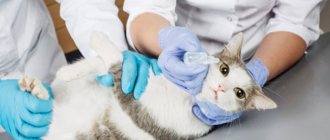© JaneA Kelley, September 2012
A cat's whiskers are more than just decoration. They are like a Swiss army knife for a soldier - a whole set of tools that provide orientation and perform communication functions. The mustache not only helps determine one’s position relative to other objects, serves as a measure to assess the ability to pass through a hole, but also allows one to express emotions and mood. Here are some interesting facts about cat whiskers.
The mustache hairs are extremely sensitive.
The roots of a cat's whisker hair are located much deeper in the skin than the hairs of its fur, and the area around the roots is very rich in nerve endings and blood vessels. This gives them such sensitivity that they can detect the slightest vibrations in the air. Because of this sensitivity, cats may experience pain if their whiskers get caught on something, such as when eating from a small but deep bowl. Pressure on the whiskers can be alarming, so use wide plates or flat feeders for food.
Mustaches can change color.
Cats' whiskers are usually white. However, the mustache is often black or red. Sometimes some of the mustache is black, some is white, sometimes different hair has different colors. It happens that one hair is painted in several colors. Don't be surprised if your black cat develops white hairs in her whiskers as she ages: cats also begin to turn gray as they age, although this is not as noticeable in non-uniform colors. It happens, on the contrary, that the mustache turns black - this does not indicate health problems.
Posted by Kotizm March 6, 2016
Many people wonder whether cats have black whiskers and why they fall off and break off. It will be equally interesting to find out what they are correctly called and what function they perform in cats, cats and kittens, because few of those who keep such cute pets in an apartment or private house know about this.
The article discusses basic questions about cat whiskers, interesting facts and everything that every cat lover should know about their pet, so that in case of any problem, they can correctly provide help and know what needs to be done.
What are cats' whiskers called?
Whiskers in cats are scientifically called vibrissae. It is believed that a cat's whiskers are thickened and coarse hairs endowed by nature with mechanical sensitivity.
Is it possible to cut or trim a cat's whiskers?
Trimming a cat's whiskers is strictly contraindicated. A cat without a mustache will not be able to navigate in space. Whiskers serve as tactile and olfactory receptors.
Why does a cat need mustaches and eyebrows, what are they needed for, what are they responsible for
Whiskers and eyebrows in cats (more correctly whiskers) are needed so that the animal can navigate in space. These are natural navigator antennas.
Why do cats and kittens' whiskers break, fall out, and become long?
Periodic loss of whiskers in cats, with replacement with new ones, is the norm. If the whiskers fall out or break off intensively, this is a sign of a malfunction in the animal’s body.
Mustache loss can be caused by: - lack of vitamins; - due to food allergies; — malfunctions of the thyroid gland; - skin diseases of a fungal nature or caused by parasites (notoedrosis or microsporia).
It is paradoxical, but true, that long and thick whiskers in cats are not always a sign of excellent health. Scientists have found that their carriers often have impaired vision.
Disease prevention measures
There is a practical possibility of preventing the development of breast cancer. If it is not important for you to have further offspring from a domestic cat/dog, then veterinarians recommend sterilizing it before its first heat. In this case, the likelihood of further breast diseases (cancer) tends to zero.
Spaying after the second (maximum third) heat reduces the risk of mammary gland diseases by 25 percent.
In any case, consult with specialists on this issue (veterinarians). We recommend visiting several clinics to have a complete understanding of breast diseases and ways to prevent them.
Functional significance of whiskers in cats
A cat's whiskers are an organ of touch that is located not only on the muzzle, but also in certain places throughout the body, on the ankles and paw pads. Vibrissae have a fairly wide range of purposes; they perform the following tasks:
- Allows you to navigate in the surrounding space;
- With their help, cats easily avoid obstacles without crashing into them;
- Using vibrissae, the cat estimates the area of the room, as well as the speed of the wind flow and the strength of the wind;
- Serve as a warning element of the individual’s mood for others;
- With its whiskers, a cat detects which direction an object is moving or a sound is coming from;
- Determine weather conditions;
- Serve as an organ of vision in blind individuals.
Causes of loss
If your cat's whiskers fall out, don't panic right away. First of all, having noticed such a phenomenon, it is necessary to observe for some time the behavior, general condition of the pet, and whether a new whisker grows in place of the one that fell out. In most cases, the loss of a mustache is not associated with any disease or abnormality in the body. Some pets lose them as a result of fights with other individuals, others are too curious and come close to the fire, after which the whiskers simply become scorched.
It is normal for cats to change their whiskers. Vibrissae can fall out at any time, regardless of the molting period of the individual.
In some cases, disappearance of whiskers may indicate developing health problems in the animal. Such reasons include the following factors:
- hypothyroidism is a disease associated with increased activity of the thyroid gland;
- infections of bacterial etiology;
- the presence of parasites in the body;
- diabetes of any type;
- allergic reaction;
- metabolic disorder.
Stages of tumor development
The development of any tumor can be divided into several successive stages:
- The neoplasm is very small, no more than 10 mm, no metastases have been identified;
- The tumor grows up to 30 mm, all the same, without the appearance of secondary lesions;
- A growth over 50 mm in size, the appearance of ulcers and the possibility of developing metastases in the lymph nodes are noted;
- Identification of secondary lesions in the liver and other organs of the animal;
By starting treatment in the first stages, you can prevent complications and completely normalize the animal’s condition.
Symptoms of deviations
If a cat's whiskers have disappeared, then the specific disease can be determined using the accompanying symptoms. For example, with hypothyroidism, there is a significant deterioration in the appearance of the coat. The cat becomes too active and nervous. The pet constantly requires a lot of food, but at the same time its body weight decreases. There is constant thirst. In rare cases, vomiting and diarrhea may occur. If the absence of whiskers is accompanied by scratching and wounds on the face, then this is a clear sign of parasites. When a pet has problems with bowel movements, diabetes can be suspected (most often diagnosed in adults and old animals). An allergic reaction is manifested by loss of whiskers and hair, itching, increased salivation, redness of the mucous membranes, and oozing secretions from the eyes. Failure in metabolic processes is often accompanied by an increase in temperature and changes in heart rate.
Infectious diseases
If a cat has black crusts on his nose that do not heal for a long time, the cause should be sought in infectious diseases. Associated symptoms of infectious diseases:
- Nasal discharge.
- Conjunctivitis.
- Otitis.
- Frequent sneezing.
- Decreased appetite.
- Lethargy.
- Increased sleepiness.
In this case, the animal may refuse to eat and be lethargic. Particularly severe forms of infectious diseases are accompanied by vomiting, diarrhea, and dehydration.
Cat infections are very dangerous, especially if the animal does not have all the necessary vaccinations. Black crusts on the nose are one of the most harmless symptoms; in severe cases, infectious diseases can lead to the death of the pet. You cannot try to cure the cat yourself; you should take the animal to a veterinary clinic. This may require long-term hospital treatment.
Crusts on a cat’s nose can be the result of skin pathologies and dermatitis. These diseases are caused by fungi and bacteria. To accurately determine the cause of the formation of crusts, it is necessary to undergo a series of tests, including a nasal microflora smear and skin scraping from the affected area. The doctor will also illuminate the animal with a special lamp, which allows you to quickly determine the presence of fungal infections.
Treatment depends on the type of disease. For fungal infections of the epidermis, antimycotic drugs are used. Treatment is carried out using ointments and solutions for treating the nose. In case of a bacterial infection, the crusts should be treated with antibacterial drugs, for example, Levomekol ointment.
For dermatological diseases, antiseptic treatment of the affected area is mandatory. This is necessary to prevent secondary infection. For this purpose, a solution of chlorhexidine or miramistin is used.
Treatment methods
If the owner discovers that his pet is losing important elements of touch, then it is necessary to assess the general condition of the animal. In case of previous activity, there is no need to worry. It should be noted that some breeds tend to break their whiskers. In most cases it is noted among sphinxes. If the loss of whiskers is accompanied by accompanying symptoms, you should visit a veterinarian. The earlier the disease is diagnosed, the easier it is to cope with it. The goal of therapy is to stop the loss of whiskers, eliminate concomitant symptoms and the underlying disease. When visiting a veterinary clinic, an examination and tests are prescribed. Based on the results obtained, effective treatment is determined. The owner needs to feed his furry friend properly, carry out preventive measures to combat parasites, and take him for examination to the veterinarian.
Proper care, nutrition and a caring attitude will allow the cat to recover in a short time, a healthy pet will delight the owner and all household members.
How to determine if it is a tick
The danger of becoming infected with ear mites exists even when the animal does not leave the house. A person can bring infection into the house along with shoes or clothing. The arthropod penetrates the cat's ear, settles there and reproduces.
An infected cat immediately changes in behavior: it becomes apathetic, it loses interest in toys and things, and the animal is indifferent even to its favorite treats. In return, the owner may get an aggressive and timid pet that does not make contact with humans and avoids touching, especially the ears.
Particular attention should be paid to the nature of the plaque. The discharge is dark brown in color, difficult to remove, and the substance itself smells unpleasant. In addition, traces of pus or blood may appear.
If there is a tick, the cat becomes restless and tries to scratch its ears all the time. Sometimes he may sit with his head slightly tilted to the side.
When the disease becomes advanced, black crusts begin to fall out of the cat’s ears, and treatment of the chronic form becomes labor-intensive and the most expensive. If you notice the first signs of ear mites, you should immediately contact a veterinarian.
What is black plaque in the ears? These photos will help you figure it out:
The doctor will scrape the animal’s ears, conduct an analysis, identify the source of the disease and prescribe appropriate treatment. In the initial form of infection, ear drops can be used, but the advanced form will require treatment with antibiotics and painkillers.
Also, during treatment, your pet must be given special food and vitamins to support the immune system and speed up recovery.
The incubation period for ear mites is 21 days. Therefore, if other animals live in a house with an infected cat, it is better to isolate the sick pet from contact with other inhabitants, and the room should be thoroughly disinfected.
It's worth taking ear mites in your pet seriously. If the necessary measures are taken too late or not at all, the cat may completely lose his hearing.










